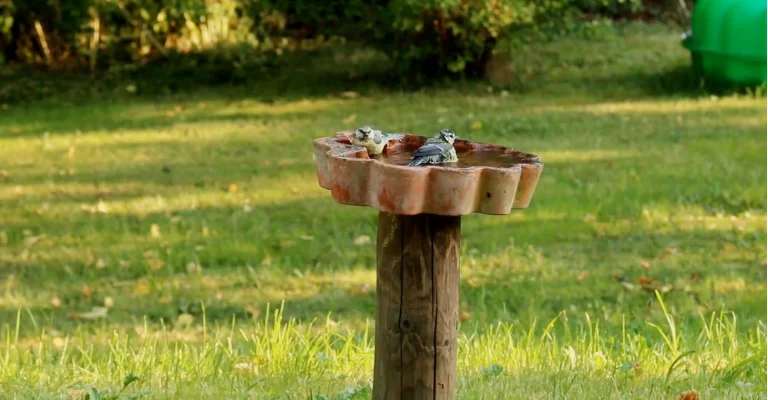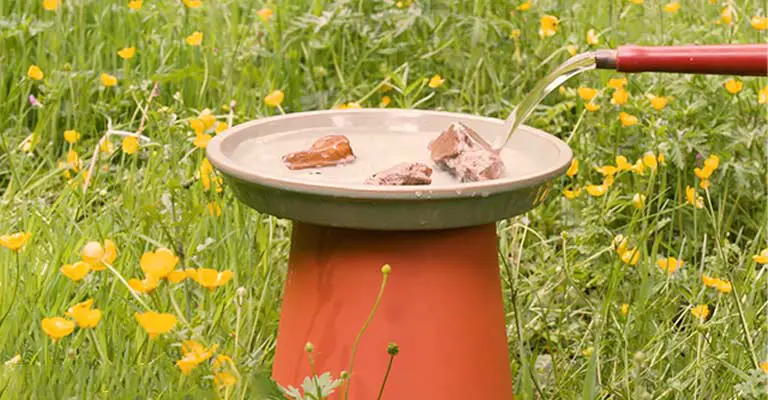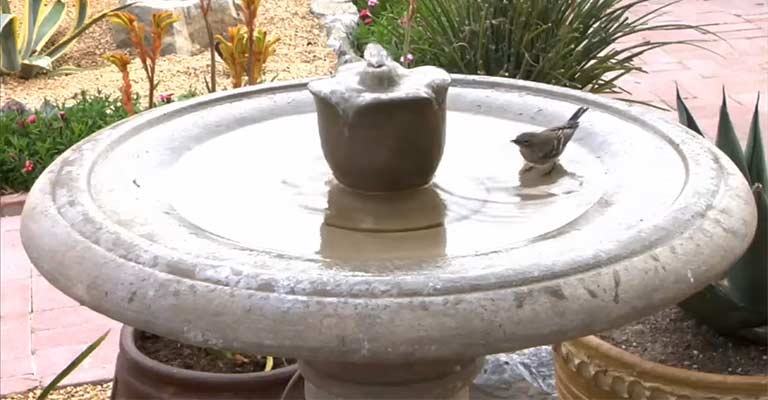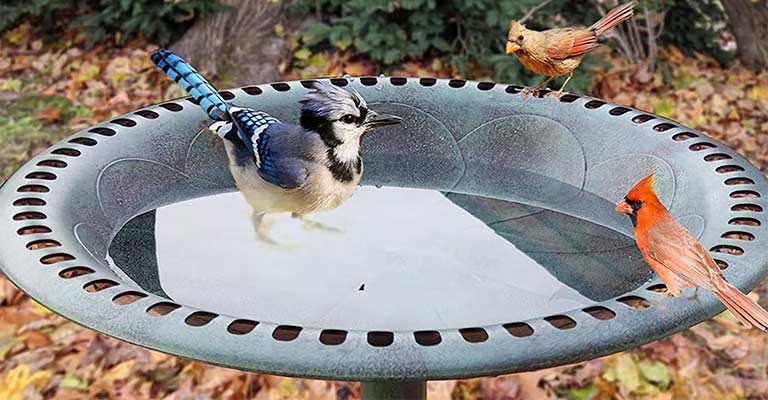Bird baths are a delightful addition to any garden, enticing our feathered friends with a refreshing haven. As we delve into the intricacies of these avian watering holes, it’s crucial to weigh the advantages and drawbacks they bring to our avian companions and outdoor spaces.
So, what are the pros and cons of bird baths? The world of bird baths is a tapestry woven with both advantages and considerations. The gentle trickle of water can create a serene atmosphere, fostering a habitat that goes beyond mere aesthetics.
However, challenges such as maintenance, hygiene concerns, and potential safety issues for birds may lurk beneath the surface. As stewards of these avian retreats, our choices impact the well-being of our feathered companions.
Join us on a journey to uncover the nuanced world of bird baths, where the symphony of nature meets the practicalities of caring for our airborne guests.

Pros and Cons of Bird Baths
While the advantages of bird baths are substantial, it’s important to acknowledge and address the potential challenges and considerations associated with bird baths. Balancing these aspects ensures that you create a habitat that benefits both the birds and your garden environment.
Let’s embark on a journey through the enchanting world of bird baths, where the symphony of nature harmonizes with practical considerations. Delve into the pros and cons, discovering the secrets to creating an avian haven in your own backyard.
What Are the Pros of Bird Baths?

Bird baths offer a range of advantages, enhancing both the aesthetic appeal of your outdoor space and the well-being of the avian visitors. Here are some key advantages to consider:
Hydration for Birds
In regions with erratic rainfall or during drought periods, bird baths become vital reservoirs for birds. Providing a consistent water source ensures that birds can meet their hydration needs, supporting their survival, especially in challenging environmental conditions.
Promotes Bird Health
Beyond mere hydration, regular bathing aids in feather maintenance. Birds use water to preen and clean their plumage, removing oils, dirt, and parasites. This grooming process is essential for maintaining feather flexibility, insulation, and overall health.
Attracts a Variety of Bird
The sound and sight of water are irresistible to birds. Installing a bird bath transforms your garden into a diverse habitat, attracting species that may not visit feeders alone. This diversity contributes to the overall health of the ecosystem.
Facilitates Social Interactions
Bird baths become communal gathering spots where birds engage in social behaviors. From playful splashing to assertive displays, observing these interactions provides insights into avian social structures and behaviors.
Enhances Garden Aesthetics
Bird baths come in various designs, materials, and sizes, allowing you to choose one that complements your garden’s style. Whether it’s a classic stone basin or a contemporary sculpture, a well-placed bird bath elevates the visual appeal of your outdoor space.
Photography Opportunities
The stillness of birds during their bathing rituals offers photographers a unique opportunity to capture detailed and vibrant images. Bird baths serve as natural stages for photographers to document the beauty and diversity of local bird species.
Educational Value
For educators, parents, or anyone interested in bird watching, a bird bath provides an up-close and personal view of avian behavior. It becomes a living classroom, offering insights into the life cycles, habits, and adaptations of various bird species.
Year-Round Attraction

Unlike seasonal food sources, bird baths provide a consistent attraction throughout the year. This year-round engagement fosters a continuous connection between humans and birds, allowing for ongoing observation and appreciation.
Natural Pest Control
Birds are voracious insect consumers. By encouraging birds to visit your garden through a bird bath, you inadvertently support a natural pest control system. Birds feast on insects, reducing the need for chemical interventions in your garden.
Therapeutic Enjoyment
The calming sound of water combined with the graceful movements of bathing birds creates a therapeutic ambiance.
Bird watching has been linked to stress reduction and improved mental well-being, making a bird bath a valuable addition to spaces designed for relaxation and contemplation.
Temperature Regulation
Bird baths offer birds a means of regulating their body temperature, especially during hot weather. Birds can cool down by bathing in the water, and this behavior is crucial for species that lack sweat glands.
Birds often use dampened feathers and softened materials for nesting. A bird bath serves as a convenient spot for birds to moisten and collect materials like twigs and leaves, aiding in the construction of their nests.
Overcoming Water Scarcity
In urban environments where natural water sources may be scarce, bird baths play a vital role in providing an accessible water supply.
This is particularly significant as cities expand and natural habitats diminish. During migration, birds are constantly on the move and may face challenges finding suitable water sources.
Bird baths along their migratory routes serve as crucial rest stops, allowing them to refuel and continue their journey.
What Are the Cons of Bird Baths?

While bird baths offer numerous advantages, it’s essential to consider the potential drawbacks and challenges associated with their installation and maintenance. Here are some cons to be mindful of:
Disease Transmission
Stagnant water in bird baths can become a breeding ground for bacteria, fungi, and parasites. This creates a risk of disease transmission among birds. Regular cleaning is crucial to mitigate this concern.
Mosquito Breeding Ground
Standing water in bird baths can attract mosquitoes, turning the feature into a potential breeding ground. This poses health risks for both birds and humans. Implementing mosquito prevention measures, such as adding mosquito dunks, is essential.
Maintenance Demands
Bird baths require consistent maintenance to ensure water quality. Regular cleaning, scrubbing, and refilling are necessary to prevent the buildup of algae, debris, and contaminants that could be harmful to birds.
Safety Hazards
The reflective surface of the water can be misleading for birds, especially during bright sunlight. Birds may mistake it for a clear pathway and collide with surrounding structures.
Placing the bird bath in a strategic location or adding decals to make the glass more visible can help mitigate this risk.
Predatory Threats
Bird baths can attract predators, such as neighborhood cats, looking to capitalize on the concentrated bird activity. Ensuring the bird bath is placed in an open area, away from potential hiding spots for predators, can help address this concern.
Freezing in Winter
In colder climates, bird baths can freeze during winter, limiting their availability to birds. Using heated bird baths or regularly breaking and replacing ice can address this issue and ensure a year-round water source.
Potential for Drowning
Bird baths with deep basins pose a risk of drowning, especially for small birds or fledglings. Opting for shallow bird baths or incorporating stones or other perches within the water can provide a safer environment.
Attracting Unwanted Wildlife
Besides birds, bird baths can attract other wildlife, such as squirrels or raccoons, which may disrupt the peaceful bird-watching experience or potentially damage the bird bath.
Evaporation in Hot Climates
In hot and dry climates, water in bird baths may evaporate quickly. Regular monitoring and refilling are necessary to ensure a consistent water source for birds, especially during peak heat periods.
Cost and Installation
Quality bird baths can come with a price tag, and additional costs may be incurred for accessories like heaters or water additives. Additionally, the installation process may require effort, particularly if you choose a more complex or decorative design.
The visual appeal of a bird bath may diminish over time due to weathering, staining, or algae growth. Regular cleaning and maintenance are necessary to preserve its aesthetic charm.
Limited Impact on Some Bird Species
While many bird species are attracted to bird baths, some may not be as inclined to use them. Factors such as the bird’s natural habitat, behavior, or reliance on alternative water sources can limit the effectiveness of bird baths for certain species.
FAQs
How often should I clean my bird bath?
Regular cleaning is crucial to prevent the buildup of algae, bacteria, and contaminants. Aim for cleaning at least once a week, more frequently during warmer months or if you notice any signs of water discoloration or debris.
What can I add to the water to keep it clean?
Consider adding bird-safe water additives or water treatments to prevent algae growth and maintain water clarity. Additionally, using a bird bath brush for scrubbing and rinsing during cleaning helps ensure a healthier environment for the birds.
Can I use tap water in my bird bath?
Yes, tap water is generally suitable for bird baths. However, if your tap water contains high levels of chlorine or other chemicals, consider letting the water sit for a few hours before adding it to the bird bath.
How can I prevent mosquitoes around the bird bath?
To deter mosquitoes, consider adding mosquito dunks, which release a natural bacteria toxic to mosquito larvae. Additionally, regularly changing the water and keeping the bird bath clean minimizes the risk of mosquitoes breeding in the standing water.
Are heated bird baths necessary in winter?
In colder climates, heated bird baths can be beneficial to ensure birds have access to water even in freezing conditions. These heated options prevent the water from freezing entirely, providing a vital water source for birds during the winter months.
Conclusion
The allure of bird baths lies in their ability to transform a garden into a haven for avian visitors, contributing to the ecosystem’s diversity and fostering a tranquil ambiance.
The pros, including the promotion of bird health and the sheer joy of observing their playful interactions, underscore their positive impact on both nature and our well-being.
However, it’s imperative to acknowledge the cons – the diligence required in maintaining water quality, potential safety hazards, and the necessity for seasonal adjustments.
By recognizing the dual nature of bird baths, we empower ourselves to cultivate spaces where nature and human coexistence thrive. Striking a balance between these aspects is key to reaping the rewards of bird baths while mitigating potential challenges.
Ultimately, by understanding both sides of the coin, we can make informed choices, ensuring that our feathered friends continue to grace our gardens with their presence, enhancing our connection to the natural world.